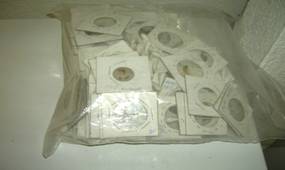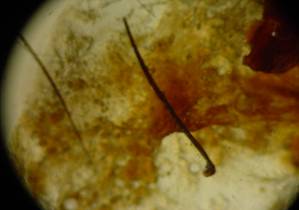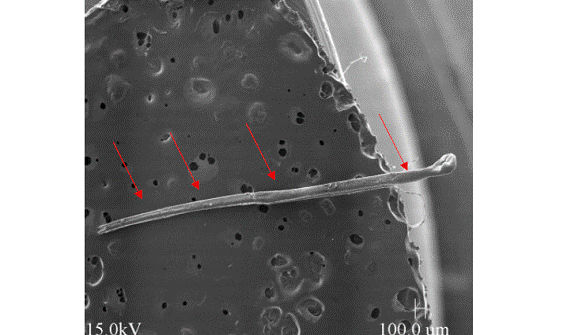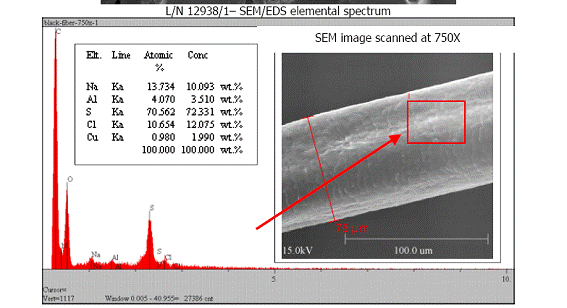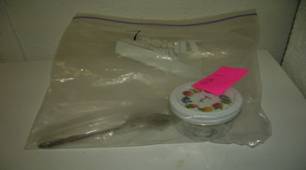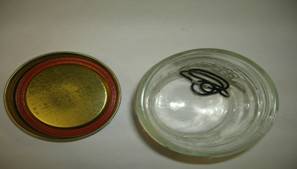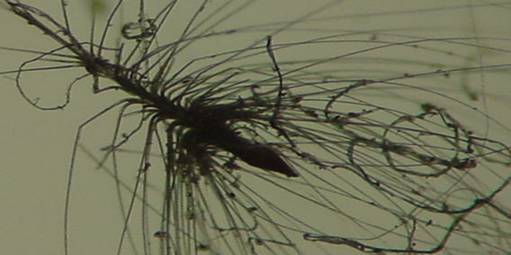- INDEX
- PROJECT FMM - FIBERS, METEORITE & MORGELLONS
-
- Project FMM - Phase IA - Initial Specimen
Examination
- Project FMM - Phase IB - High Density Polyethlyne
Fiber
- Project FMM - Phase II - Chemtrail Fallout
- Project FMM - Phase IIIA - Morgellons Fibers
Tested and Compared
- Project FMM - Phase IIIB - Raman; Morgellons
& Meteorite
- Size
Matters - Dr. Hildegarde Staninger
-
-
- PROJECT FMM Fiber, Meteorite & Morgellons
PHASE IA Initial Examination of Several Dozen Samples
-
- March 29, 2007
PROJECT FMM (FIBER, METEORITE & MORGELLONS)
-
- Principal Researcher Dr. Hildegarde Staninger,
RIET-1
© Saturday, March 27, 2007
INTEGRATIVE HEALTH INTERNATIONAL, LLC
12235 Centralia Street, Lakewood, CA 90715
Tel: 562-402-7300 Fax: 562-402-7308 Direct: 213-382-2786
Project Contract Labs: AMDL, Inc., ACS, Inc., MIT, and Lambda Solutions,
Inc.
-
-
- PHASE IA Samples from Sept. 1, 2006.
Results Received February 5, 2007
-
- Subject Samples of Unknown Fibers Collected form Many
Sources and Delivered to Laboratory.
-
- Report of: Examination, Microscopic Measurements and
Spectrographic Analysis of Several Dozen Fibers Sent from IHI, LLC, Lakewood,
CA.
-
- INTRODUCTION
-
- Several batches of unknown suspect fibers were sent to
the laboratory over a period of several weeks. We were asked to examine
them, study them microscopically, determine some physical properties, and
run elemental analysis by energy dispersive spectroscopy (EDS) and chemical
groups by Fourier transform infrared spectroscopy (FTIR). Also some samples
would be analyzed by Fourier transform Raman spectroscopy (FT-Raman).
-
- Laboratory personnel would also compare the fibers with
some other nanofibers reported to be carbon-silicon fibers with photoluminescent
and other properties.
-
- NOTE: All Samples were compared to the "Goldenhead"
as found by Dr. Rahim Karjoo and Dr. Hildegarde Staninger (October 28,
2006) and a fiber that was identified as High Density Polyethylene Fiber
(HDPE).
-
-
- RESULTS
-
- 1) Visually a few of the fibers resembled the carbon-silicon
fibers previously studied by Integrative Health International, LLC.
-
- 2) Close-up photos and photomicrographs (1,000 x) were
taken of most samples.
-
- 3) Many strange shapes and lumps were seen and some could
not be identified.
-
- 4) Identification of the photomicrographs were identified
to contain a "foreign fiber" or not. These fibers were then selected
for further testing and melting points.
-
- 5) A FTIR spectrum of one spot on the fiber indicated
the presence of high density polyethylene fiber plus a trace of another
material (brown gel).
-
- 6) EDS and Raman results will be discussed in Phase II
and Phase III of this report.
-
-
- SUMMARY
-
- The fibers identified, gel material, and gel shaped materials
had no cellular integrity with no eukaryotic cells. The materials
identified in the fibers were of a manufactured nano technology to form
a specific structure with an undetermined function. The chemical composition
of fibers that had EDS and Raman did not match the chemical composition
of the human body nor were they any part of the human body (nails, hair,
skin, nerves, etc.).
-
- Special features as identified by Los Angeles County
Fire Department, Los Angeles, CA personnel are the following: 1) skin melts
or burns at above 165 degrees F; 2) fibers from a human body that do not
melt at 1,400 degrees F or above 165 degrees are not made of human cells;
and 3) human tissue does not secrete gels nor would they be of known human
cellular composition that melt above 300 degrees C (i.e. approximately
over 600 degrees F).
-
- All samples that did have a fiber that matched nanotechnology
as compared to the original "Goldenhead" was identified as a
"Morgellon Like Fiber": 1) discarded Morgellon Goldenhead; 2)
fully formed Morgellon Goldenhead; or 3) deteriorating Morgellon Goldenhead.
The structured material/fibers identified were ones that would have properties
to self assemble, enlarge, and/or fold/expand. They were identified as
nanotechnology (man-made)1 and were not identified in any way to be composed
of eukaryotic cells, animal, plant, nor composed of any live biological
form. Some specimens had "biological artificial" appearances
that are known as artificial life or pseudo-life forms. These types of
artificial life forms are known to use DNA/RNA/siRNA or sRNA plasmid templates
of viruses, microorganisms, animal/plant proteins and/or enzymes to build
the artificial technology structural form at nano level. Furthermore, they
are not limited to only these referenced life forms plasmids, enzymes,
and/or proteins.
-
-
- Dr. Hildegarde Staninger, RIET-1, Principal Investigator,
IHI, LLC Dept. Research & Dev.
- Industrial Toxicologist/IH & Doctor of Integrative
Medicine
-
- Footnotes:
- 1 Man-Made means not made by nature or found in nature.
-
- Morgellons Photos, Special Program #6, Page Three of
Five
- http://www.rense.com/general74/morg6-3.htm
-
-
-
L/N 12938/1
(See Phase III B for detail)
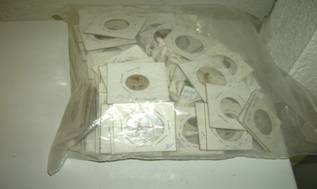
VARIETY
-
-
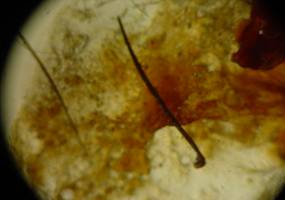
-
L/N 12938/2
-
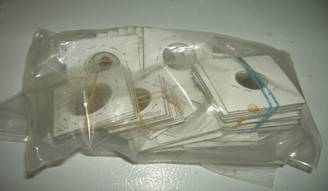
-
12939/2
-
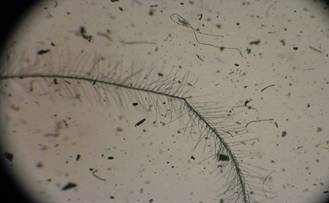
-
-
L/N 12938/3
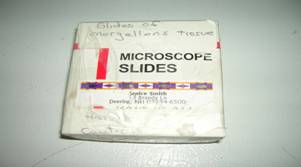
-
SLIDE No 12
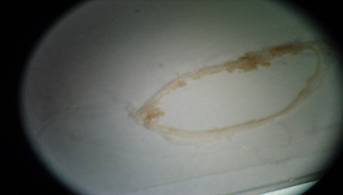
-
-
- SEM/EDS Elemental Spectrum
- (Image Scanned at 100X missing from
online file)
-
| Atomic % |
Conc |
|
|
| Na |
Ka |
16.145 |
12.273 wt.% |
| Al |
Ka |
18.274 |
16.304 |
| P |
Ka |
18.961 |
19.420 |
| S |
Ka |
33.403 |
35.419 |
| Cl |
Ka |
6.098 |
7.149 |
| Ca |
Ka |
7.120 |
9.435 |
| |
|
100.00 |
100.000 wt% |
| |
|
|
|
-
L/N 12938/4
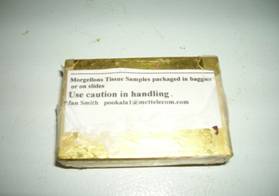
-
-
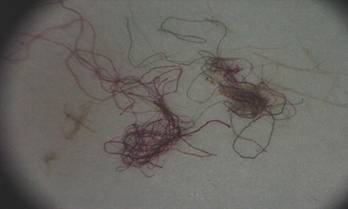
(No Data)
-
L/N 12938/5
-
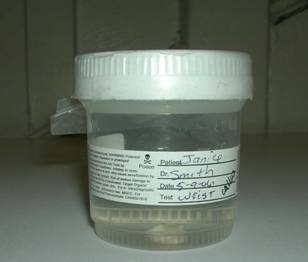
CALLUS
Negative for specific fiber configuration.
L/N 12938/6
Morgellons Tissue Samples in Alcohol
New lesion on left breast. Many particles were
of gelatinous glowing blood.
Fiber samples including striated strands.
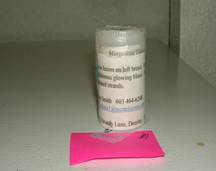 (No data)
L/N 12938/6
Morgellons Tissue Samples in Alcohol
New lesion on left breast. Many particles were
of gelatinous glowing blood.
(No data)
L/N 12938/6
Morgellons Tissue Samples in Alcohol
New lesion on left breast. Many particles were
of gelatinous glowing blood.
Fiber samples including striated strands. One particle
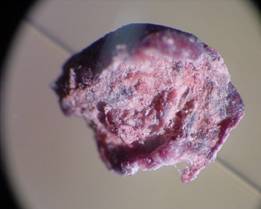 L/N 12938/7 - PR FRESS (Meteorite) See Phase
III B Report for detail
L/N 12938-B1 thru L/N 12938-B10 - Ten more specimens
were examined,
L/N 12938/7 - PR FRESS (Meteorite) See Phase
III B Report for detail
L/N 12938-B1 thru L/N 12938-B10 - Ten more specimens
were examined,
photographed and found negative for specific fiber configuration.
PROJECT FMM PHASE I-B
(Fibers, Meteorite & Morgellons)
Phase I - B Identification of High Density Polyethylene
(HDPE) Fiber from
"BB" a patient at IntroCell, Pensacola, FL. Specimen collected
by a Health Advocate.
Samples From September 1, 2006
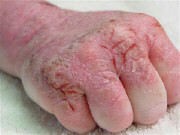 .. ..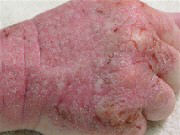 .. ..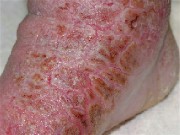
 SAMPLES FROM "BB", 8-14-06 Caution:
SAMPLES FROM "BB", 8-14-06 Caution:
Biohazard Threat. Not sure (if there's fiber) but it fell off of her leg
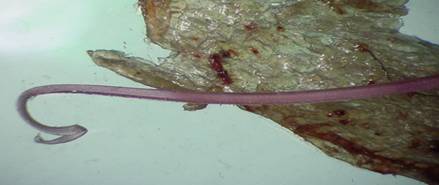
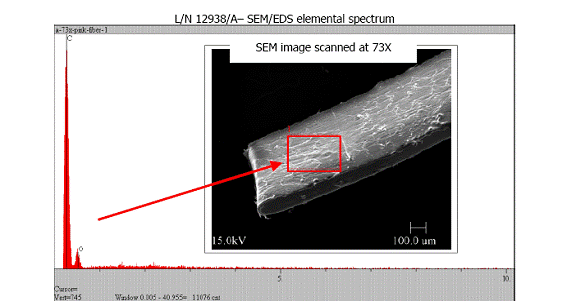
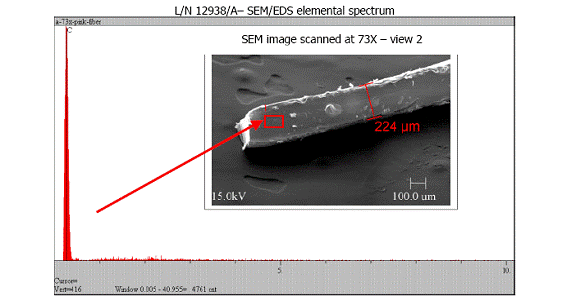 L/N 12938A FT-IR Spectral Overlay
L/N 12938A FT-IR Spectral Overlay
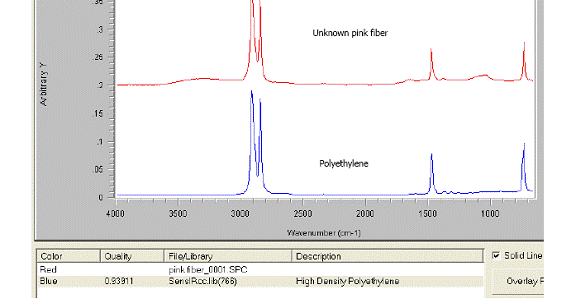
-
-
-
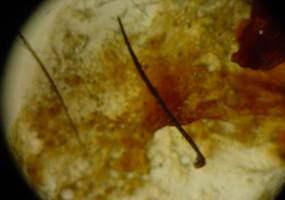
L/N 12938-1 (square slides) for comparison
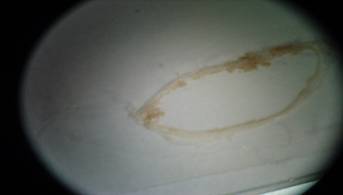 L/N 12938-3 for comparison
L/N 12938-3 for comparison
PROJECT FMM (FIBER, METEORITE & MORGELLONS)
PHASE I-B High Density Polyethylene, & Further Analyses
- Phase I-B
-
- Principal Researcher: Dr. Hildegarde Staninger,
RIET-1
© Saturday, September 1, 2006
INTEGRATIVE HEALTH INTERNATIONAL, LLC
12235 Centralia Street, Lakewood, CA 90715
Tel: 562-402-7300 Fax: 562-402-7308 Direct: 213-382-2786
Project Contract Labs: AMDL, Inc., ACS, Inc., MIT, and Lambda Solutions,
Inc.
-
- PHASE I (Part B) Samples from Sept. 1, 2007.
Results Received: February 5, 2007
-
- Subject: Samples of Unknown Fibers Collected
form Many Sources and Delivered to Laboratory.
Report of: Examination, Microscopic Measurements and Spectrographic Analysis
of
Several Dozen Fibers Sent from IHI, LLC, Lakewood, CA.
-
-
- INTRODUCTION
-
- Several batches of unknown suspect fibers were sent to
the laboratory over a period of several weeks. We were asked to examine
them, study them microscopically, determine some physical properties, and
run elemental analysis by energy dispersive spectroscopy (EDS) and chemical
groups by Fourier transform infrared spectroscopy (FTIR). Also some samples
would be analyzed by Fourier transform Raman spectroscopy (FT-Raman).
-
- Laboratory personnel would also compare the fibers with
some other nanofibers reported to be carbon-silicon fibers with photoluminescent
and other properties.
-
- NOTE: All Samples were compared to the "Goldenhead"
as found by Dr. Rahim Karjoo and Dr. Hildegarde Staninger (October 28,
2006) and a fiber that was identified as High Density Polyethylene Fiber
(HDPE).
-
- The following results specifically address the tests
performed on the High Density Poly-ethylene (HDPE) fiber from a patient
of Dr. Staninger's whom she consulted with at IntroCell, LLC, Pensacola,
FL. The specimen sample was from a piece of skin that fell from "BB's"
foot Sample No. 12938-A. Sample No. 12938-1 and 12938-3 will be addressed
for SEM/EDS data.
-
- RESULTS
-
- 1) Visually a few of the fibers resembled the carbon-silicon
fibers previously studied by Integrative Health International, LLC.
-
- 2) Close-up photos and photomicrographs (1,000 x) show
the pink fiber to the left of picture of Sample No. 12938-A.
-
- 3) A FTIR spectrum of one spot on the fiber indicated
the presence of high density polyethylene fiber plus a trace of another
material (brown gel). Fiber size 0.8 um and a melting point of 115 degrees
C.
-
- 4) SEMS/EDS results show various concentrations as stated
below
-
- Sample Number 12938, % composition
-
- A
|
1 |
3 |
|
| Element Found |
"BB" |
- Square Slides
|
- JS
|
- Sodium (Na)
|
- |
- 3.510
|
- 16.304
|
- Aluminum (Al)
|
- |
18.961 |
19.420 |
- Sulfur (S)
|
- |
- 72.331
|
- 35.419
|
- Chloride (Cl)
|
- |
- 12.075
|
- 7.149
|
| Ca |
- |
7.120 |
9.435 |
| Copper (Cu) |
- |
- 1.990
|
- |
| Calcium (Ca) |
- |
0.980 |
9.435 |
| Phosphorous (P) |
- |
- |
19.420 |
| Carbon, C |
yes |
yes |
yes |
| Oxygen (O) |
yes |
yes |
yes |
| HDPE, fiber |
yes |
carbon/silica |
No |
| Melting Point, oC |
115 |
None Stated |
None Stated |
-
-
- SUMMARY
-
- The fibers identified, gel material, and gel shaped materials
had no cellular integrity with no eukaryotic cells. The materials identified
in the fibers were of a manufactured nano technology to form a specific
structure with an undetermined function. The chemical composition of fibers
that had EDS and Raman did not match the chemical composition of the human
body nor were they any part of the human body (nails, hair, skin, nerves,
etc.).
-
- Special features as identified by Los Angeles County
Fire Department, Los Angeles, CA personnel are the following 1) skin melts
or burns at above 165 degrees F; 2) fibers from a human body that do not
melt at 1,400 degrees F or above 165 F degrees are not made of human cells;
and 3) human tissue does not secrete gels nor would they be of known human
cellular composition that melt above 300 degrees C (i.e. approximately
over 600 degrees F).
-
- Sample 12938-A "BB"
-
- The specimen shows carbon and oxygen present with the
EDS test. The other elements were to minimal to be detected. The specimen
was tested with Raman Test and found to be High Density Polyethylene Fiber
(HDPE) with a trace of another compound. The other compounds have not been
identified. Its Melting Point is 115 degrees C with a 0.8 um length.
-
- Sample 12938-1 "Square Slides"
-
- The specimen had no calcium present but did have high
amount of sulfur with trace copper. It did contain sodium, aluminum, and
chloride. These are all used as a battery or catalyst in creating a battery
similar to the Edison Cell or Lead Cell. Edison cell type batteries utilize
iron, potassium hydroxide, and nickel oxide, while a lead cell type uses
-
- Lead, lead oxide, lead sulfate and hydrogen sulfate.
Note copper in this sample. A compound known as chalcopyrite, CuFeS2 is
roasted in an air process to create copper sulfate, iron oxide and sulfuric
acid. When sand (silicon dioxide, SiO2) is added a low melting point occurs
and produces iron silicate. Copper is very oxidative with various stages,
but in its cupric copper stage a blue color is obtained when it is contained
within 4 to 5 water molecules (CuSO4 . 5H2O. The blue color of this solid
is due to the Cu+2 ion hydrated by four of the five water molecules in
a surrounding square planner arrangement.
-
- Specimen 12938-3 "JS"
-
- JS has submitted previous samples and did have the "Goldenhead"
identified in her samples with a melting point of above 1400 degrees F
by Toxicological Pathology studies of Dr. Hildegarde Staninger and Dr.
Rahim Karjoo.
-
- Sodium is present with significant aluminum, phosphorous
and primarily sulfur. Chloride is present with calcium. Calcium was not
present in 12938-1, while copper was present.
-
- Sulfur was 35.419 % in this specimen and 72.331 % in
Sample No. 12938-1 ("Square Slides"). All of the transitional
elements and other halogens are reactive or establish various valence stages
when exposed to water. It is believed that these elements using the bio
terrain they are in as their resource for building materials utilize various
to develop into various fibers and other artificial nano life forms. It
is very important to note any amount of cupric ion is toxic to lower organisms,
so it is used to suppress the growth of algae in ponds and fungi and molds
on vines. Bordeux mixture used to spray grapes and potatoes is made of
copper sulfate and lime.
-
- Calcium carbonate (which has been made into double walled
nano tubes with carbon), CaO3, decomposed upon heating to form carbon dioxide
gas, CO2 and calcium oxide (lime), CaO: + under a vacuum at 800 degrees
F. If not done under a vacuum other compounds can from such as methane,
oxygen, carbon dioxide and water. It may be noted that in ALL of the samples
(ChemTrail, 12938-A, and -1) any sample with calcium and oxygen may have
originally been calcium carbonate and lime. The samples with copper, sulfur,
calcium and oxygen may have been similar compounds such as Bordeux mixture
but at a nano scale level. These statements are based on the data received
and history of a burning glass needle injection feeling by some Morgellon
individuals.
-
- A future question would be what is keeping these nano
materials at equilibrium and what is their life expectancy under "normal"
and "varying" conditions.
-
- Dr. Hildegarde Staninger, RIET-1, Principal Investigator,
IHI, LLC Dept. Research & Dev. Industrial Toxicologist/IH & Doctor
of Integrative Medicine
-
-
- Footnotes:
-
- 1 Man-Made means not made by nature or found in nature.
-
- =================
-
- Silica Nanotubes Based on Needle-like Calcium Carbonate:
Fabrication and Immobilization for Glucose Oxidase, Ind. Eng. Chem. Res.,
46 (2), 459 -463, 2007. 10.1021/ie060935+ S0888-5885(06)00935-3,
- http://pubs.acs.org/cgi-bin/abstract.cgi/iecred/2007/46/i02/abs/ie060935+.html
-
- Web Release Date: December 15, 2006, Copyright ©
2006 American Chemical Society
-
- =====================
-
- Nanocyl 9000 Series Datasheet,
-
- High Density Polyethylene Nanocomposite Powder
- http://www.nanocyl.com/ecommerce/pdf/tech2.pdf
-
-
- PROJECT FMM (FIBER, METEORITE & MORGELLONS)
-
- CHEMTRAIL FALLOUT
- PHASE II
Principal Researcher Dr. Hildegarde Staninger, RIET-1
© Saturday, March 27, 2007
-
- INTEGRATIVE HEALTH INTERNATIONAL, LLC
12235 Centralia Street, Lakewood, CA 90715
Tel: 562-402-7300 Fax: 562-402-7308 Direct: 213-382-2786
Project Contract Labs: AMDL, Inc., ACS, Inc., MIT, and Lambda Solutions,
Inc.
-
- PHASE II Samples from January 8, 2007.
Results Received March 20, 2007
- Subject: Three Samples of Unknown Suspect Fibers
Delivered to Laboratory.
Report of: Visual and Microscopic Examination and Spectrographic Analysis
of Suspect
Fibers Collected by Integrative Health International, LLC.
-
-
- INTRODUCTION
-
- Phase II consists of a second batch of unknown suspect
fibers were sent to the laboratory. They were asked to examine them, study
them microscopically, take photomicrographs, and to determine some physical
properties, and to run elemental analysis by energy dispersive spectroscopy
(EDS). They would also compare their properties with those of other fibers
such as nanofibers, nanotubes, carbon-silicon nanowires, meteroritic particles,
Morgellons and carbon-silicon fibers.
-
- RESULTS
-
- 1. The samples were a collection of three specimens collected
by an individual in Texas. These specimens were falling from the sky after
a Chemtrail spraying in the area. The specimens streamed from the sky like
spider webs and landed on the plants, grass and back yard of the individual.
A stick was used by the individual to collect the specimens. They
were then placed in a plastic ziplock bag and saved for future analysis.
These specimens were submitted to IHI, LLC for analysis under Project:
FMM. The specimens received appeared to be like a clump of 3 white spider
webs or white cotton candy. Meteorite fibers findings reported in Phase
III of PROJECT: FMM.
-
- 2. These fiber samples resemble some of the previously
submitted fibers but not the Morgellon's "Goldenhead", which
we will call a primary reference figure. They do resemble a Morgellon's
"Goldenhead" that is either 1) not fully developed; 2) being
discarded or 3) deteriorating. Note the shape and the SEMs picture of the
standard silicon based nanotube/wire that has the "memory" shape
of a tongue that is bent down/up (due to position of reference).
-
- 3. EDS data for the three fiber samples show the presence
of six elements: sodium, aluminum, phosphorus, calcium, sulfur and chlorine,
which could be due to natural mineral fibers. Further testing by Raman
in Phase III shows they were nanotechnology (man-made structures).
-
- 4. EDS data does have carbon and oxygen present for all
samples. The carbon and oxygen was taken out of the total percent
composition so a total percentage of trace elements could be identified.
The elements identified were transitional elements. Transitional elements
are known for their high magnetism and valence charge. They are used in
making electro-magnetic batteries. (Further discussion of batteries in
separate document.)
-
- 5. Sample 13263-1 has within its nanotube an outline
of a pre-Morgellon like structure known as "Goldenhead". Note
the extremely high amount of calcium 69.994%, sulfur
-
- 1.517 %, chlorine 18.129%, potassium 5.559% and iron
4.801%, and NO silica. Note the outline of a "Goldenhead" with
distinct features of a muzzle like a wolf at 3 o'clock. SEM is at 1,500x
and scale of 20 microns.
-
- 6. Sample 13263-2 (no SEM picture). Note the extremely
high amount of potassium 30.222%, calcium 12.905%, iron 18.442%, sulfur
11.117%, chlorine 21.567% and silica 5.767%. A general question of these
EDS data as compared to Sample 13263-1 is that the calcium makes the nanotube,
thus when it breaks down by the surrounding bio terrain, it will produce
a carbon-silica nanowire or a silica wire.
-
- 7. Sample 13263-3 (no SEM picture). Note the extremely
high amount of iron 41.515%, silica 12.999, sulfur 8.791%, chlorine 16.403%,
potassium 13.406% and calcium 6.885%. If silica percentage rising 12.999%
as compared to Sample 13263-1 then a more defined carbon-silica or silica
wire is being formed. The high value of iron 41.515%, sulfur, chloride,
potassium in the presence of oxygen to form iron oxides and other transitional
oxides/ -OH an electro-magnetic continuous electrical cell could be formed
which would be commonly known as a "battery". The higher developed
pre Morgellons "Goldenhead" would then not need a nanotube but
would be allowed to move within the body freely, especially under the skin.
A paper written by Marcus Mighty, Nanorobot Mechanocompatibility, Department
of Mechanical Engineering and Energy Processes, Southern Illinois University
at Carbondale © May 5, 2005:
-
- ( http://www.engr.siu.edu/mech/faculty/hippo/ME465SP05mightyPaper.doc)
clearly states that the problem with nanorobotic devices is that as they
pass through the skin they cause excessive bruising, itching and other
disturbances. . . . Nanorobots must be mechanically able to withstand interaction
not only with other tissues and cells, but also other nanorobots interacting
within the body. . . . Nanorobots used in medical monitoring are made of
diamond and diamonoids (if zirconia or liquid zirconia melting point 1,500
degrees C to 3,000 degrees C). . . . . With nanorobots performing various
duties around the body, there would be reasons to consider whether these
nanorobots would cause irritation around different areas of the body. One
irritation that the nanorobot could cause is excessive itching. This could
happen around areas such as the ears or the mouth (or other orifices).
-
- 8. Specimen 13263-1 contained 36.167 % Carbon and 51.501
% Oxygen.
-
- Specimen 13263-2 contained 48.486 % Carbon and 39.943
% Oxygen.
-
- Specimen 13263-3 contained 47.267 % Carbon and 47.139
% Oxygen.
-
- Note when carbon is in these ratios and in the present
of transitional elements with oxygen present electro-magnetic cells are
made and a reverse micelle reaction could occur due to the interaction
of the human cell and the water present outside a cell (fresh) inside the
cell (salt) water. If this is occurring in these specimens once in the
body a high conductivity value will be observed.
-
- SUMMATION:
-
- The specimens were collected and submitted to IHI, LLC
by an individual in Texas. The SEM images resemble a Morgellon like "Goldenhead"
within a nanotube. These three specimens were from fiber particulate fall
out after a Chemtrail spraying. These materials once on the ground surface
may be broken up into smaller pieces which may be classified as nano arrays,
if each section functions as an individual unit. These nano materials can
self-assemble, replicate and enlarge.
-
- Dr. Hildegarde Staninger, RIET-1, Principal Investigator
Project: FMM
- Industrial Toxicologist/IH & Doctor of Integrative
Medicine
-
- Footnote:
- 1 Man-Made means not made by nature or found in nature.
-
-
- Texas Respondent, Chemtrail Droppings
Summer, 2006 (specifics on file)
-

-
- L/N 13263-1
-
- FIBER 1
-

-
-

-

-
-
-
- L/N 13263/2
-
- FIBER 2
-
-

-

-

-
-
- L/N 13263/3
-
- FIBER 3
-
-

-
-

|



 ..
.. ..
..




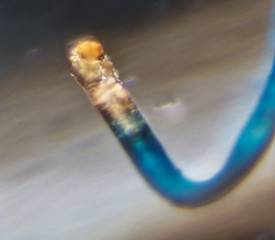 ..
..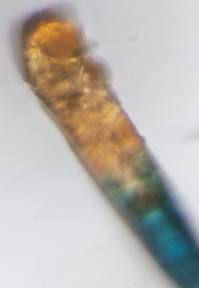 ..
..
